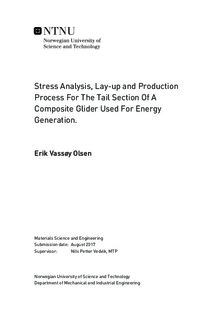Stress Analysis, Lay-up and Production Process For The Tail Section Of A Composite Glider Used For Energy Generation.
Master thesis
Permanent lenke
http://hdl.handle.net/11250/2464343Utgivelsesdato
2017Metadata
Vis full innførselSamlinger
Sammendrag
Kitemill is developing a new concept to harness wind energy. Their concept is shaped like a glider, and takes advantage of the high wind speeds at high altitudes. Operations in such environments require strong and lightweight materials. This thesis will focus on the production method, material type and lay-up for a structural composite beam inside the horizontal stabilizer.Kitemill currently use wet lay-up bladder moulding technique to make the part. In this process where an inflatable bicycle tube is used to generate pressure on the composite in a closed mould. The maximum load of the piece they made by this process was set as the benchmark loading. The material used in this production method is a combination between Textreme (76 gsm) and Renlam M1 Epoxy. This material combination was tested according to the ASTM standard of composite testing, with some simplifications. The laminate constants were calculated from these results. These constants were used to create an Abaqus model which simulated the bladder moulded beam in a three-point bending test. A second production technique was created. The aim was to build a sample that could take the benchmark loading, but weighing less. This was done by creating a parametric optimization of lay-up for composites with the software program Isight. This lay-up was used together with a compression moulding technique where a core-material is squeezed into the mould. Pre-Preg composite material was used for this concept.The results indicated that the focus should be changes from the maximum load to production quality . The compression moulding production technique seems to be a better alternative than the bladder moulding technique due to air bubbles in the laminate. However, this is a more expensive production technique. The structure of the optimization program is good, but it needs some adjustments before it can be useful for real design applications. The program was computational heavy because the program had too many variables. There was also a problem with the way the simulation was set up. The result av this was that Abaqus ignored the difference between a continuous ply and a non-continuous ply. The conclusion is that the bladder molding technique can be used for the prototype glider, but the material should be changed to Pre-preg to minimize production flaws.
